

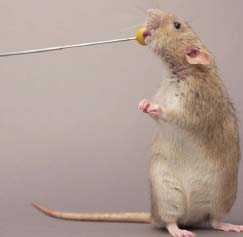
This rat is learning to sit up—one of the training behaviors you will want to teach him.
NOW THAT BEN AND IRA COME WHEN CALLED AND can walk with you and your target stick, you can progress to training some really fun behaviors! As a professional rat trainer for film and television, I have taught these clever critters to perform stunts of great skill and daring. I am happy to share my methods with you, but if you don’t feel fully confident you can re-create these behaviors safely, don’t despair. There are enough low-risk tricks in these pages to keep you and Ira busy for ages. In this chapter, you’ll learn how to train your rat to stand on his hind legs, negotiate obstacles of all sorts, stay in one location, and ride on your shoulder—plus how to link several behaviors so that your rat will perform many different commands for a single treat.
This is called behavior chaining—combining two or more behaviors prior to marking the moment of completion. You’ve actually already done this with teaching your rat to turn his head, move toward your tap, and wait for his reward. That was a chain of behavioral events. Now, with just a bit more time and effort, your rat might really impress!
Training your rat to stand on his hind legs is probably easier than teaching him to come when called. Standing upright, balanced on his hind legs, is one of the rat’s natural postures. It helps the rat to reach things and see over obstacles. If you feed your rat with tongs, you can hold the food over his head. Automatically, the rat will reach up for the food. As he does so, click and give him the food. This trick is easiest with lab blocks, fruit, and vegetables, which are big enough for you to easily hold with tongs and for your rat to grab.
As your rats are familiar with the concept of target luring, teaching Ben and Ira to stand on their hind legs should be a cinch. Gradually shape the behavior as follows:
Gradually increase the distance between the stick and the working surface. For example, begin with 2 inches, then repeat the exercise from 3 inches. When your rat performs consistently with the target stick 3 inches from the working surface, move to 4 inches. Never try to push your rat beyond his limits by holding the stick way out of reach. This will extinguish your rat’s desire to perform. Don’t expect your rat to reach beyond reason. Until he is good at the behavior, in fact, your limit should be no higher than your rat’s body length (not including his tail).
Ever watch dogs run through an agility course? They walk over high boards, A-frames, and seesaws; weave through poles; jump over obstacles; and go through tunnels. When a rat goes through a maze and figures out which direction to take to obtain a reward, he is performing an exercise very similar to that performed by a canine on an agility course. There’s no reason why you can’t add some rat-size obstacles to the routine to have some fun with your rodent.
Because rats are very agile and love to investigate new places, you can make the obstacles as large as you wish. However, if you are expecting your rat to jump over mountains, forget it. Rats are very good at leaping but don’t generally leap very high, and they’ll rarely leap over an obstacle they can climb over. If you are planning on making some rat jumps, you’ll want something close to the ground and sturdy—this isn’t stadium jumping, after all.
You can, however, make obstacles that require climbing as tall as you like. Rats can easily climb almost any surface. They are especially agile rope climbers, an ability no dog can match. There’s no need to spend a lot of money, for you can make an entire obstacle course with rope alone.

Lure Ben to the opening of the tunnel.
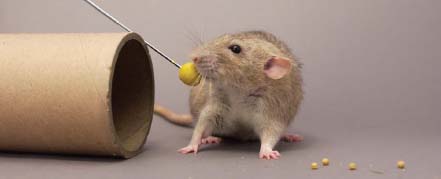
Place the tip of the target stick in the far end of the tube to draw him in.
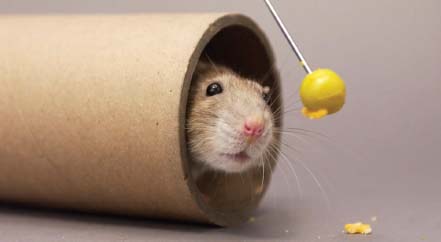
Lure Ben all the way through, then click and reward. Following food into the tunnel makes it even more fun for the rat. Treasure hunt!
A tunnel can be made of pipe cleaners and cloth, or you can buy some large-diameter PVC pipe. The great advantage of PVC is that it comes premade in a wide range of widths and corner fittings, so you can make an entire maze out of one material. PVC tubing is also very easy to clean: just rinse and dry. Another great feature is that your rat will not likely chew on it as he would on cloth. Cloth makes great nesting material. Plastic is not as comfortable.
I also suggest making weave poles out of PVC, as any wood product will likely be chewed. The half-inch-diameter pipe works well for this purpose. For outdoor play, poke it into soft ground. For an indoor course, glue it to a thick board.
Should you want to have your rat exercise outdoors, excellent barriers are now on the market that keep small animals within a 20-cubic-foot area. The material is a strip of sleek plastic that can be attached with Velcro at the ends, giving you and your little ones a great area to play in safety. Think of all the fun you can have setting up the little agility course and running your rat through!
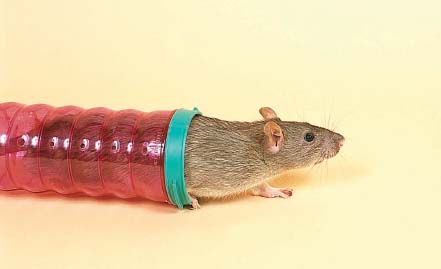
This rat is exploring a colorful store-bought plastic tunnel.
Ben and Ira can be easily taught to negotiate any agility obstacle through luring, one step at a time. The speed at which your rat learns how to go over, through, or under something depends on his food drive, as you will be luring him a few steps, clicking and rewarding when he arrives, then luring him a few more steps. I’d suggest you conduct a training session prior to offering a meal or use the feeding time itself as a training session. Rats would much rather actively search for their meals than have food handed to them. After all, isn’t it more fun to search for treasure than to have it plopped in front of you?
To train Ben to go through tunnels, place a very short tunnel, one even shorter than your target stick, on the working surface. Position yourself at the exit end and slide the target stick through the tunnel so that the end extends through the entrance. Tap the end of the target stick to get Ben’s attention. As he comes toward the tunnel, retract the stick to the entrance. Click and reward as Ben goes to the entrance. Next, pull the stick through the tunnel a little ways, close enough so to you that you can reach in with a piece of food once Ben is halfway through. As you draw the target stick all the way through the exit, with rat in tow, click and reward again. After repeating this procedure a couple of times, you should be able to merely tap the tunnel, and your rat will go through it to get his food on the other side.
Repeat the tunnel acclimation exercise using several different tunnel configurations—say, a couple of straightaways of different lengths connected by some corners. Gradually add more pieces. When Ben is readily going through one assembly, add another part. Within a fairly short time, you should have a great tunneling rat.
If Ben and Ira ever show reluctance to go into a tunnel, merely place a morsel of food inside. You could leave a trail of little bits all through the tunnel, giving your rat positive associations with going into the small, tight space—not that Ben and Ira will need much prodding, as rats normally love going into small, darkened spaces. Once the rats are comfortable in the section containing food morsels, you will easily be able to transfer the positive associations to other parts of the tunnel system.
Now let’s put together an entire agility course. We need to combine all the different obstacles that your rat has learned to negotiate one at a time. You can begin by chaining two obstacles. When Ben and Ira reliably and successfully traverse these two, add another. Continue in this manner until you have designed an entire agility course, and your rats are having a great time negotiating all the obstacles for one click and reward. Your rats will be having so much fun that the activity becomes its own reward.
What’s more fun than walking around with a rat on your shoulder? Not only does a shoulder-riding rat give you ease of mobility, but the novelty of your little pet is also sure to draw glances from passersby. If you’ve been walking your rat on a leash through the neighborhood, you should be used to the attention by now.
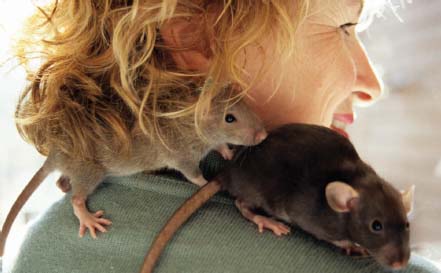
Two rats are twice the fun of one—especially when it comes to shoulder rides.
Rats love to explore their world. Going on a shoulder-riding journey is a real thrill. But before you plop your rat on your shoulder and take off, you must prepare Ben and Ira for the experience and take some safety precautions.
First, Ben needs to learn how to remain in one spot for extended periods of time. It simply won’t do to have your rat crawling all over you as you move about. He might fall!
You’ll need to teach your rat to respond to the stay command. This is done through a very gradual shaping process, using your target stick or a small piece of cloth.
As most rats, especially females, naturally prefer moving around to sitting still, it might take a while to teach the stay command. Be patient, and reward the minor increments. In time, with consistent training, you’ll succeed.
Begin by deciding whether you want to teach your rat to remain on a piece of cloth or to target on the stick. You’ll need to carry whichever target you choose with you when you move around so that Ben and Ira will have consistent cues to respond to.

Teach your rat to go to a specific material in order to begin teaching the stay or go to commands (washcloths work great).
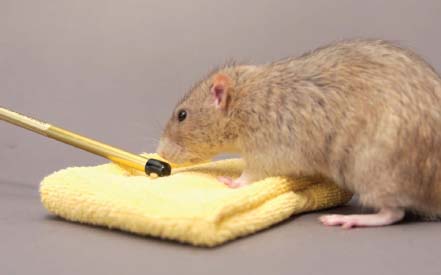
Ira will learn to go to his mark faster if you teach him through targeting.
The training procedure depends on the target you use. Let’s assume you use the target stick.
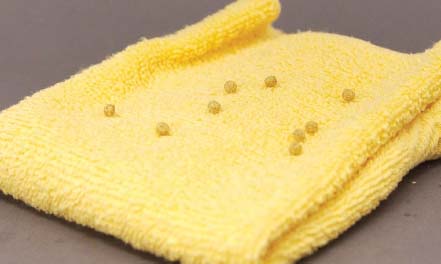
Placing food on the cloth marker will make your rat believe that the marker is a very positive place to be.
If you reach a point—say, after 5 seconds—when Ben begins to move away from the target stick, back up to clicking after he holds the position for 4 seconds. Do three to five repetitions. When he’s comfortable remaining in place for 4 seconds, try the 5-second increment again. Sometimes, you have to regress in your criteria before you can progress in your training.
Now, let’s try this exercise using a piece of brightly colored cloth as a target. This target might be the better choice if you intend to move around while your rat is on your shoulder. Holding a target stick against your shoulder is far more difficult than pinning the cloth to your shirt. A cloth target also gives your rat something besides your shirt to cling to as you move.
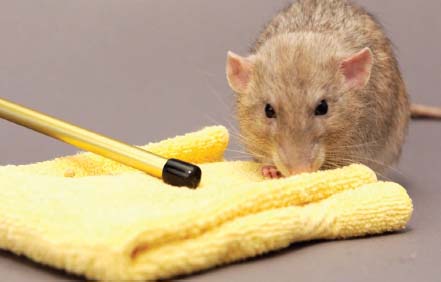
This rat has learned that the cloth marker brings great things.
Once Ira is readily going to the cloth and waiting for his food, it’s time to teach him to wait for the click. Gradually increase the amount of time he must remain on the cloth before you click and reward. Increase the delay in 1-second increments, just as you would using a target stick.
Once your rat readily goes to its target zone and remains there for short periods of time (e.g., 15 seconds), place the target on a different surface and work on the same exercise. Choose a place that is not quite level and is fairly narrow, such as the back of a chair or couch—the point is to prepare your rat for riding on your similarly sloped shoulder.
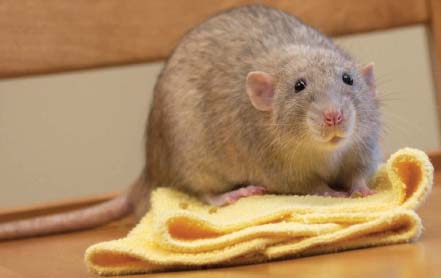
The cloth marker can be placed anywhere, and the rat learns to remain on the cloth.
Now we’re ready for the big event. Place your rat on your shoulder. Once he’s in the right location, either on the piece of cloth or near your target stick, click and give him a food morsel. Repeat this four or five times. Gradually increase the amount of time between clicks and treats.
When your rat comfortably and reliably remains in one place on your shoulder for at least 20 seconds, begin walking around. Move very slowly at first and try not to lean or in any way give your rat a rocky ride. No one likes to drive with someone who can’t shift the transmission smoothly. After walking a few seconds, stop, click, and reward your rat. Gradually increase the amount of movement as you increase the length of time your pet remains perched on your shoulder.
You’re almost ready to take the circus outdoors. Before you do, take appropriate safety precautions. You never know when your rat might fall or purposely skitter off to investigate something irresistible, so put Ira’s harness on before you go outdoors. Tie the leash to a belt loop or around your wrist. Bring your clicker, food morsels, and a pouch to carry it all. You’ll want something that offers easy access to the food without having to search. Looking for the food takes your mind off what your rat is up to. When outside, it’s very important that you are always aware of Ira’s antics.
As in all new situations, gradually increase the length of time you spend walking outdoors with your rat. Gradually introduce your rat to situations with more distractions as well. Starting your walks in a busy neighborhood or on a busy street is a great way to frighten your rat. Begin on a quiet side street or cul-de-sac. When Ben is comfortable there, go somewhere with more people and other distractions. Overstimulating your rat on his first outing will only make him want to hide in your pocket instead of looking at the world perched on your shoulder.
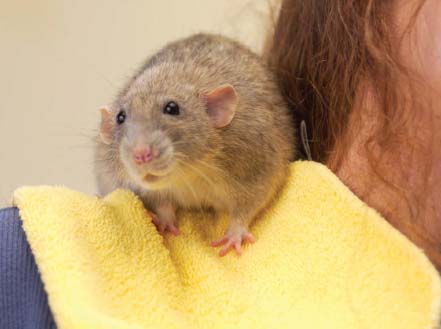
The cloth can even be placed on your shoulder if you want to teach your rat to remain in one place instead of burrowing through your hair. Pin it to your shirt for a secure perch.
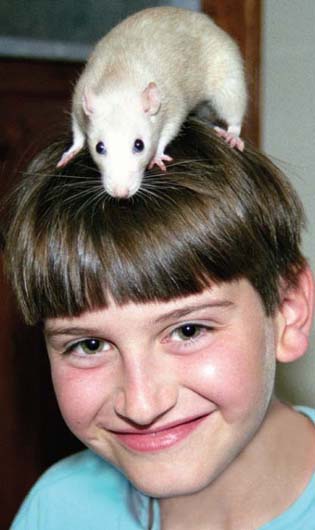
This is the best view in the house.
Once Ben and Ira are seasoned shoulder riders, you can begin teaching them more extreme shoulder-riding sports. How about taking them with you to outdoor fairs and sports activities? Or allowing them to ride shotgun as you do yardwork? Some rat owners have even trained their pets to stay on their shoulder while they skateboard or ride a bike, although these activities certainly pose more of a risk to your rider.
Rats get bored as easily as humans do. Who can be satisfied with a mere walk around the block? Add new adventures to the basic shoulder ride, and your rats will get more out of the experience.
The key is gradual acclimation. If your goal is to ride a skateboard with Ben on your shoulder, begin with short, straight, level courses on wheels. Hang on tightly to his leash, keeping it short enough so that if he does fall, he won’t hit the ground and risk being run over. As he learns to relax and enjoy the movement, add variations such as going backward, turning, and eventually going off ramps. Never do flips and leaps, however, which require total concentration on your own body position and render you incapable of safeguarding your rat.